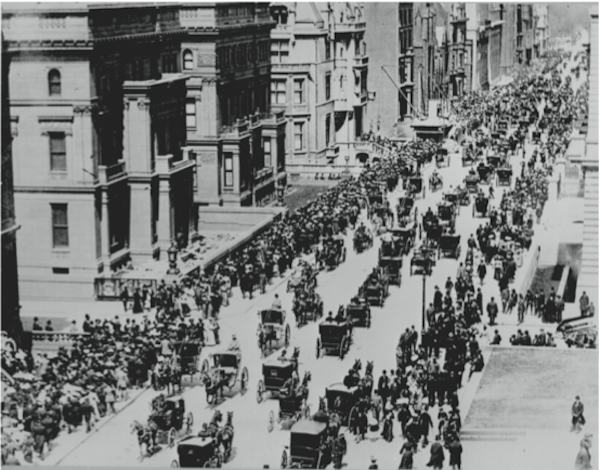This is how fast energy sources can change: from all horses but one automobile in the 1900 New York Easter Parade to all automobiles but one horse in the 1913 Easter Parade.

Source: U.S. National Archives
This is how fast energy sources can change: from all horses but one automobile in the 1900 New York Easter Parade to all automobiles but one horse in the 1913 Easter Parade.

Source: U.S. National Archives
An article that dismisses without investigation the fastest growing industry in the world, solar power, after solar has become cheaper than any other energy source, is not a serious article.
 Richard Smith wrote for Truthout 9 January 2014,
Green Capitalism: The God That Failed.
Sure,
there are lots of good points in there (such as we need a carbon tax,
but it’s not enough), but given that
only 90 companies account for 2/3 of GHG emissions
saying we can’t change that without crashing the world’s economy is
like saying we can’t deal with horse manure in cities in 1900 without
crashing the world’s economy, and
people did say things like that back then.
Richard Smith wrote for Truthout 9 January 2014,
Green Capitalism: The God That Failed.
Sure,
there are lots of good points in there (such as we need a carbon tax,
but it’s not enough), but given that
only 90 companies account for 2/3 of GHG emissions
saying we can’t change that without crashing the world’s economy is
like saying we can’t deal with horse manure in cities in 1900 without
crashing the world’s economy, and
people did say things like that back then.
Most of the world’s oil and gas is used to produce power, so once we convert to solar and wind, we’ll have plenty of remaining petroleum for other uses such as lubrication.
 Saying in 2014 that solar and wind can’t power the world is like
saying in 1994 that Continue reading
Saying in 2014 that solar and wind can’t power the world is like
saying in 1994 that Continue reading
 There is a big difference between the 19th century horse excrement
crisis and the current 21st century energy crisis,
similar as they may sound.
One was real.
The other is manufactured by the modern equivalent of stagecoach vendors.
There is a big difference between the 19th century horse excrement
crisis and the current 21st century energy crisis,
similar as they may sound.
One was real.
The other is manufactured by the modern equivalent of stagecoach vendors.
Stephen Davies wrote for The Freeman 1 September 2004, The Great Horse-Manure Crisis of 1894,
In 1898 the first international urban-planning conference convened in New York. It was abandoned after three days, instead of the scheduled ten, because none of the delegates could see any solution to the growing crisis posed by urban horses and their output.
Continue reading
The problem did indeed seem intractable. The larger and richer that cities became, the more horses they needed to function. The more horses, the more manure. Writing in the Times of London in 1894, one writer estimated that in 50 years every street in London would be buried under nine feet of manure. Moreover, all these horses had to be stabled, which used up ever-larger areas of increasingly valuable land. And as the number of horses grew, ever-more land had to be devoted to producing hay to feed them (rather than producing food for people), and this had to be brought into cities and distributed—by horse-drawn vehicles. It seemed that urban civilization was doomed.